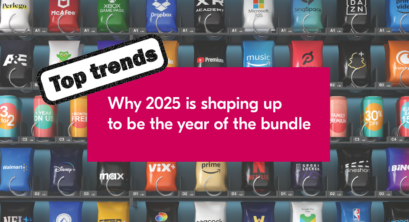Trends for 2025: The year bundling takes center stage
by Giles Tongue | 08 Jan 2025

The subscription economy is poised for a transformative year in 2025, with bundling taking prominence as a key growth strategy for content providers of all sizes. This rise in bundling is driven by the need for content providers to attract more customers, provide greater value and ultimately increase stickiness with killer bundle combinations which engage and retain customers for longer.
With bundling set to play an even greater role this year, content providers are teaming up with resellers – mobile operators, ISPs, connected TV, banks, retailers, and others – to deliver value-packed bundles that attract millions of customers.
In 2024, telcos like Verizon (MyPlan, +play) and Optus (SubHub) led the charge against subscription fatigue by creating innovative “content hubs.” These platforms consolidated streaming, gaming, music, sports, and more into seamless, centralized consumer experiences. For consumers, this meant easier subscription management and access to diverse services in one place.
According to Bango research in the US during 2024, one in five subscribers (20%) exclusively signed up through indirect channels. Top content brands are also affirming its importance stating “Bundles are revenue drivers that built our customer base. They lower churn and provide a lot of stickiness.” (Source: Super Bundling: Inside secrets report).
With 2025 shaping up to be the year of the bundle, we predict several trends that will redefine subscription services and the bundling landscape.
1. The rise of SVOD continues
In 2025, streaming will solidify its role as a critical driver of media revenue, marking a shift away from traditional TV models. This transformation reflects a change in industry perspectives, as streaming sceptics were proven wrong in 2024.
For years, critics doubted the sustainability of streaming, citing shrinking margins and monetization challenges. However, Netflix shattered these doubts with record financial results, shifting its focus from subscriber numbers to average revenue per consumer. Similarly, Disney+ offset declines in traditional TV, driving growth that turned potential losses into gains for its TV division. We will see continued experiments in ad-funded such as partial ad-funded tiers and short-term ad-free periods.
2. “Live” – The key to boosting ad-tier subscriptions for streaming services
Live events such as sports bring something that few other content types can: continuous engagement and real-time community experiences. For advertisers, they’re a goldmine – delivering large, captive audiences willing to sit through ads. For streamers, they’ll become increasingly crucial in 2025 to ensure their ad-funded tiers thrive.
We’ve already seen this play out in 2024. Amazon has expanded its NFL coverage, Apple TV+ secured global soccer deals, and Netflix have experimented with a boxing exhibition event, turned a regular NFL game into something more like the Super Bowl final with Beyonce half time spectacle, and have invested heavily in women’s football.
Live may also include experiments in daytime shows, news and weather.
3. Access over ownership – Gaming subscriptions become the new standard
The video games industry is rapidly moving towards subscription-based monetization, a trend expected to accelerate in the coming year. Microsoft’s Game Pass has paved the way, offering access to a vast library of games for a flat fee. This model gained significant traction recently, with major releases like Call of Duty launching directly to subscription platforms.
This shift mirrors broader changes in consumer preferences, with players favoring access over ownership. By this time next year, the subscription model could dominate the gaming industry, reshaping how players engage with content and setting new benchmarks for monetization success.
4. The emergence of multi service apps
Single-service subscriptions are facing mounting pressure to evolve. Consumers increasingly expect their subscriptions to provide more than one use case. This doesn’t just enhance value – it also fosters stickiness by embedding the service deeper into daily routines.
Netflix is already moving in this direction – expanding from its core of original dramas and documentaries to include live sports, gaming, and even daytime TV. By creating more reasons for consumers to engage with their ecosystem, Netflix is giving us a glimpse of where the market could be headed.
5. Niche content brands turn to indirect channels for subscriber growth
Without the massive budgets of giants like Netflix and Disney+, niche players can’t afford the direct-to-consumer marketing needed to stand out. Instead, they’ll lean heavily on partnerships with resellers like telcos, ISPs, retailers, banks, and platforms like Amazon to reach audiences. By the end of 2025, bundling could account for more than half of their subscriber base.
The trend is already evident. Data from Antenna shows that 91% of specialty streaming services (e.g., Crunchyroll, or genre specific movie services like Shudder) are purchased indirectly. When telco partnerships are factored in, the percentage is even higher.
6. Telcos get creative with their product bundles
Telcos will transform how they market their own products to capitalize on the complementary nature of third-party services to drive uptake. This strategy positions products like data plans not just as a utility making their offerings more tangible and enticing.
Imagine, instead of buying a standard mobile plan, customers will subscribe to a bundle offering Netflix, Disney+, with 10GB of data bundled in, all for one price. Or telco data and travel SIM cards bundled and offered by banks.
7. YouTube will force a redefinition of broadcast TV and content distribution
Broadcasters like ITV, Channel 4, and the BBC are increasingly using YouTube to reach households without live TV, drawn by its massive audience and comparable ad revenue potential. However, this partnership poses risks. As YouTube enhances its connected TV experience, it could evolve from a complementary platform to a direct competitor, vying for the same audiences and advertising dollars.
Public broadcasters like the BBC face additional concerns, such as alienating viewers who feel they’re “paying twice” through license fees and YouTube Premium. While YouTube offers exposure, broadcasters risk losing traffic to their own apps, declining ad revenue, and weakening traditional TV’s relevance. The challenge lies in leveraging YouTube’s reach without undermining their core business.
8. Increased mergers, acquisitions and bundling as a seamless path to collaboration
Bundling is emerging as an avenue for collaboration among companies, many of whom were fiercely competitive, now moving to frenemies and coopetition. While mergers, acquisitions, and industry consolidation remain at the extreme end of the spectrum, bundling offers a practical way for businesses to work together more closely than ever before. An example of this trend is the recent collaboration between ESPN, Fox, and WB Discovery to launch their joint sports streaming platform, and the merger of Fubo with Hulu and Live TV from Disney.
Staying ahead in the bundling game in 2025
In 2025, speed to market and scalability will be critical for resellers and content providers aiming to grow and outpace the competition. Success in the bundling space – particularly with Super Bundling content hubs – requires seamless management of multiple subscription services and reseller integrations.
Relying on in-house DIY solutions can slow progress and complicate operations, making it challenging to meet the demands of a fast-evolving market. That’s where third parties like Bango with the Digital Vending Machine® (DVM™) come into play. By streamlining integration and enabling rapid deployment, businesses can deliver the variety and value consumers want, ensuring they stay ahead in the bundling race.
Subscribe to our newsletter
Get the latest subscription bundling news and insights delivered straight to your inbox.



